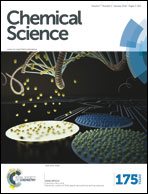Protein sensing in living cells by molecular rotor-based fluorescence-switchable chemical probes†
Abstract
In this paper, we introduce a general design to construct fluorescence-switching probes by using conjugates of a fluorescent molecular rotor and protein specific ligands for the selective protein detection and real-time tracking of protein degradation in living cells. Upon the interaction of the ligand with the protein ligand-binding domain, the crowded surroundings restrict the bond rotation of the fluorescent molecular rotor to trigger the emission of a strong fluorescence signal, which is reduced upon the addition of a competitive ligand or after protein degradation. With this probe design, two fluorescent probes for MGMT and hCAII proteins were constructed and applied for detecting the endogenous proteins in living cells. In addition, real-time degradation kinetics of the alkylated-MGMT at the single living cell level were revealed for the first time. We believe that this fluorescence-switching probe design can possibly be extended for the analysis of other proteins, for which there are still no effective tools to visualize them in living cells.


 Please wait while we load your content...
Please wait while we load your content...